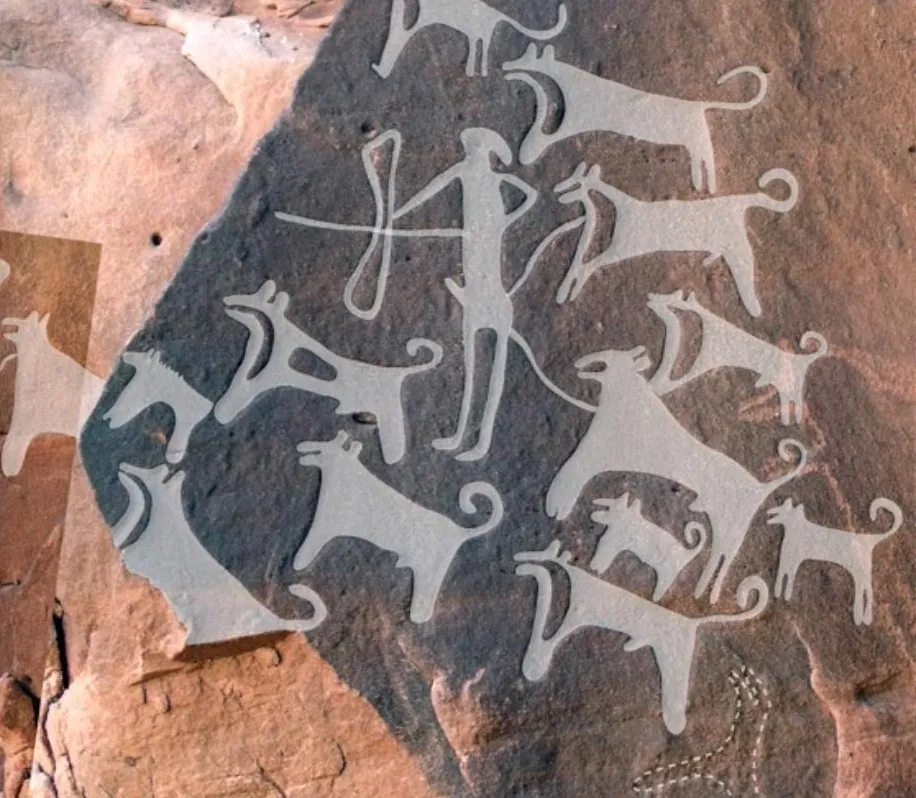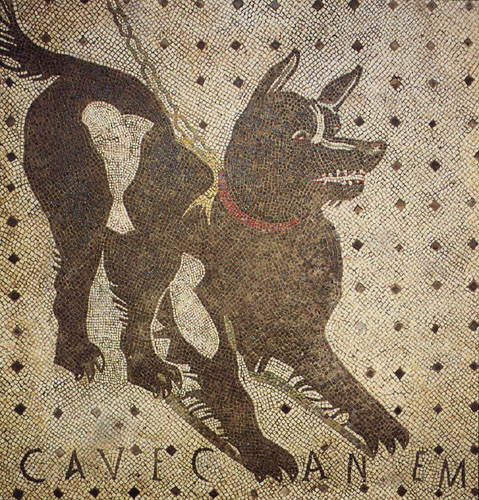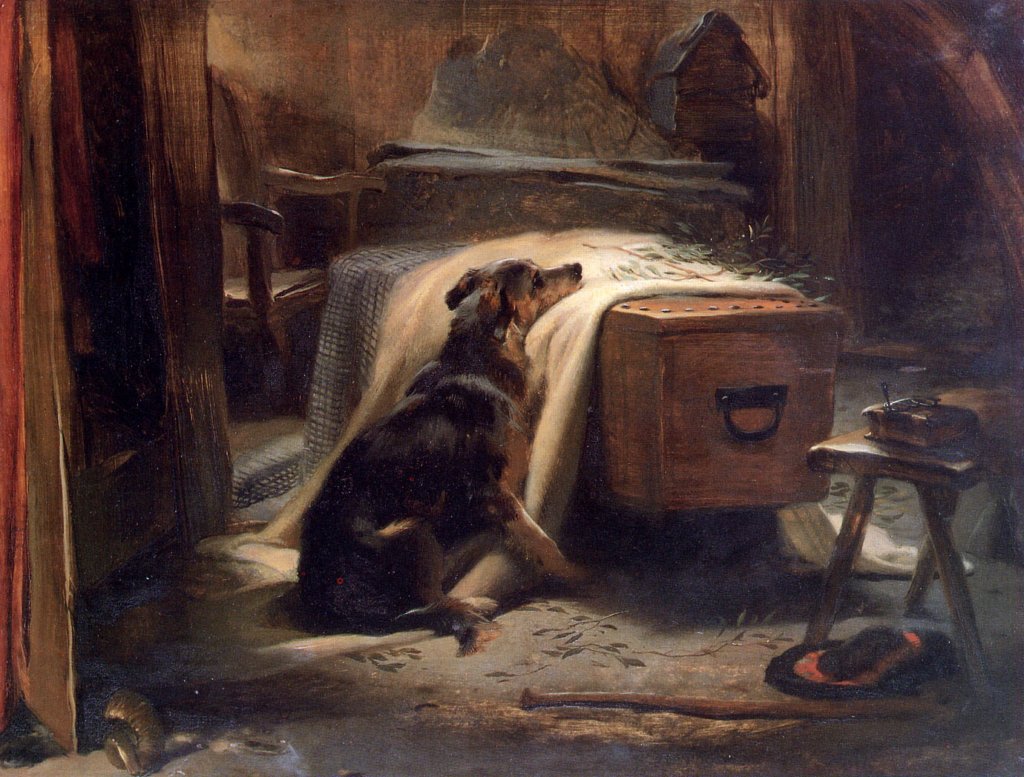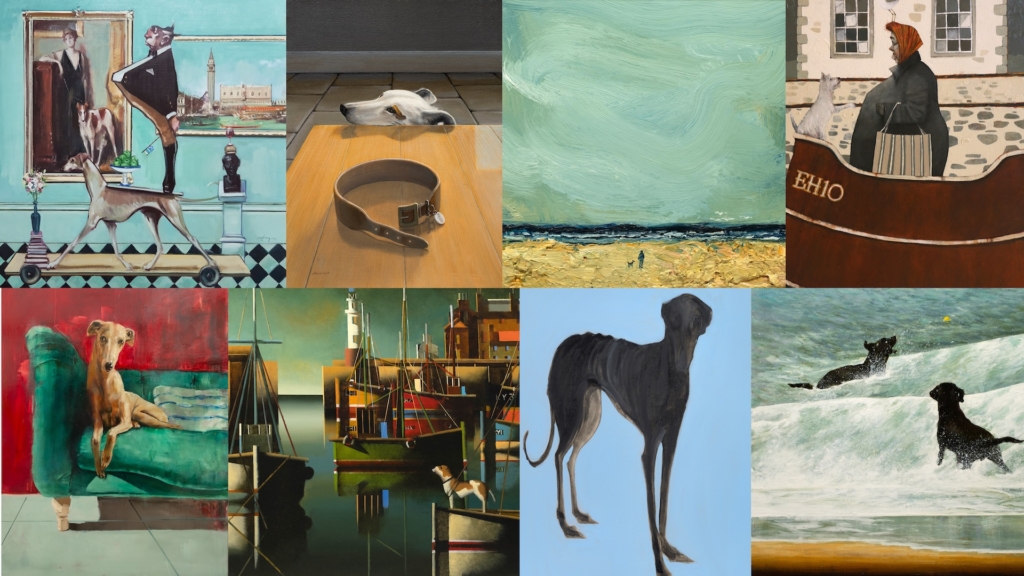A Short (But Spirited!) History of Dogs in Art
Loyal, loving, funny, fierce, and full of heart, dogs have been eternal muses across centuries and cultures. In honour of WOOF! The Dog Show and our four-legged companions, this blog takes a short (but spirited!) look through the long, tail-wagging history of dogs in art.
Prehistoric Pups and Ancient Guardians
Artistic depictions of dogs can be traced back around 8,000 years. Rock paintings and carvings found in the Sahara Desert, Saudi Arabia, and India show dogs, leashed and not, alongside humans. In Ancient Egypt, dogs were spiritual protectors, appearing in tomb art and representing loyalty, protection, and guidance into the next world. The god Anubis, with the head of a jackal or dog, was the guardian of the dead and a key figure in the afterlife.

Composite image of rock art found in Saudi Arabia depicting two scenes: on the right, a hunter with 13 dogs and possible leashes from his waist; on the left, a hunter with a large equid and eight dogs. The top image highlights the engravings outlined in white. Image credit: Journal of Anthropological Archaeology/Maria Guagnin/Max Planck Institute for the Science of Human History
Classical Companions
In Ancient Greece and Rome, dogs were depicted as icons of fierceness, fidelity, and domestic loyalty. Roman villas and tombs often included depictions of dogs guarding humans in life and death. A famous example of this is the Cave Canem mosaic originally at the entrance of the House of the Tragic Poet in Pompeii, featuring a collared dog with the warning to visitors, “Beware of the Dog”. In Ancient China, terracotta tomb figures often included dogs, depicted as playful companions and fierce protectors of nobles and soldiers.

Cave Canem, “Beware of the Dog”. Image credit: What Life Was Like: When Rome Ruled the World: The Roman Empire, 100 BC-AD 200 (1997) by the Editors of Time-Life Books
Medieval Man’s Best Friend, Renaissance Runners, and Philosophical Fidos
By the Middle Ages, dogs were common in European art, symbolising loyalty, devotion, and status. Small breeds appeared in formal portraits, like Rogier van der Weyden’s Portrait of a Lady (c. 1460) and everyday scenes like Jan van Eyck’s The Arnolfini Portrait (1434). More than decorative companions, these dogs acted as visual guides, often gazing straight at the viewer, hinting at deeper moral or emotional themes.
During the Renaissance, dogs became symbols of nobility and courage, with the Talbot Hound becoming a regular figure in family crests. By the 16th and 17th centuries, dogs took on philosophical positions, as in David Teniers the Younger’s Old Master, Philosopher Laughing at Magick (1775), where a dog-headed man stands behind a philosopher, embracing a human head, offering a symbolic reflection of philosophical practice in the time of Enlightenment. Beyond Europe, dogs featured in Japanese netsuke and Chinese decorative arts as signs of family, protection, and prosperity.

Philosopher Laughing at Magick (1775), David Teniers the Younger. Image credit: https://www.georgeglazer.com/
Victorian Dog Portraits & Early Modern Musings
In the Victorian era, dogs took centre stage as main subjects, not just companions. With the Kennel Club’s rise in the UK (1873) and US (1884), breeds became standardised, and owners commissioned proud portraits. Artists like Dutch Otto Eerelman captured lifelike St. Bernards and mastiffs. British painters such as Arthur Wardle embraced sentimentality, as seen in The Totteridge XI (1897) with its poised fox terriers. Edwin Landseer presented dogs as emotionally complex subjects with works like The Old Shepherd’s Chief Mourner (1837), where a loyal dog mourning its master became a Victorian symbol of grief and devotion, showing dogs painted with human-like care and emotion.

The Old Shepherd’s Chief Mourner (1837), Edwin Landseer. Image credit: https://collections.vam.ac.uk/item/O16452/the-old-shepherds-chief-mourner-oil-painting-landseer-edwin-henry/
Modern & Contemporary Canines
In modern and contemporary eras, dogs have stayed firmly in the frame, as companions and symbols of love, identity, and rebellion. Pablo Picasso famously adored his dachshund Lump, capturing him in the iconic Dog (1957), a minimalist line drawing that says everything in one stroke. Andy Warhol famously painted his dachshunds Archie and Amos with the same pop flair as Marilyn and soup cans, proving dogs could be pop icons. David Hockney’s Dog Days series (1995) is a tender tribute to his dachshunds, Stanley and Boodgie, capturing everyday affection. Hockney said it best: “The subject wasn’t dogs but my love of the little creatures.”

From left to right: Dog Painting 38 (1995), David Hockney; The Dog (1957), Pablo Picasso; Portrait of Maurice (1976), Andy Warhol. Image credit from left to right: https://www.afficheon.com/products/david-hockney-dog-painting-38-1995-offset-lithograph, https://www.artsy.net/artwork/pablo-picasso-the-dog-small, https://www.nationalgalleries.org/art-and-artists/41712.
Artists like Jean-Michel Basquiat and Keith Haring turned dogs into powerful motifs. Raw and chaotic, Basquiat’s Boy and Dog in a Johnnypump (1982) became one of the most valuable paintings ever sold. In Banksy’s tribute to Basquiat, Boy and Dog in Stop and Search, the dog symbolises innocence under political pressure. Keith Haring’s barking dogs are playful on the surface but arose from a place of activism and protest around the HIV/AIDS epidemic.

Left to right: Boy and Dog in a Johnnypump (1982), Jean-Michel Basquiat; Dog (1985), Keith Haring; Banksquiat. Boy and Dog in Stop and Search (2018), Banksy. Image credit from left to right: https://www.jean-michel-basquiat.org/boy-and-dog-in-a-johnnypump/, https://www.haring.com/!/art-work/758, https://banksyexplained.com/banksquiat-boy-and-dog-in-stop-and-search-2018/.
WOOF! The Dog Show at Morningside Gallery – A Tribute to Dogs in Contemporary Scottish Art
Today, dogs remain beloved furry muse, full of heart, meaning, and memory. WOOF! The Dog Show is Morningside Gallery’s celebration of dogs’ timeless charm through the lens of contemporary Scottish art. This joyful exhibition showcases how dog paintings continue to thrive, capturing everything we love about our four-legged friends: loyalty, warmth, mischief, and unmistakable woofs.
We’re proud to showcase an outstanding line-up of artists: Joe Hargan, Gordon Mitchell, Louis Sinclair McNally, Stephen Mangan, Gemma Rees, Hilke Macintyre, Gordon Wilson, Catherine Rayner, Helen Fay, Morag Muir, Denise Findlay, Lesley McLaren, Sally Muir, Richard Twose, Fiona MacRae, Brian Henderson, Stuart Buchanan, Iain Holman, Georgina McMaster, David Smith, Joyce Gunn Cairns, and James Tweedie. Each brings a heartfelt and distinctive approach to celebrating dogs in their work.
Join us in honouring the timeless bond between people and pups through this vibrant collection of contemporary Scottish dog paintings, a warm and whimsical homage to man’s best friend.
